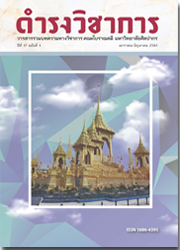Vishnu Statues in Archaeology and Art History in Thailand
Keywords:
Vishnu, Radiation X-Ray Gamma, Vishnu statue, trade routes, modelAbstract
The study of Vishnu statues within archaeology and art history in Thailand before the 14 Century C.E. illustrates that these statues are related to religion and trade routes as well as transferring art. Locational organisation can be categorized into 3 groups: eastern and northeast, central and western, and east and south western. From this study, Vishnu statues can be categorized into 5 groups. The early period statues have a relationship with Indian art that was found in the port cities along the shoreline. The later period statues that were found at ancient port cities in southern ,central, and eastern Thailand. In addition, they also illustrate the relationship with the Vishnu statues that were found in Southeast Asia. The worship of Vishnu continues into the present day. They still exist in the trading communities, for example in central Thailand. This research also found the small sized Vishnu statues in excellent craftsmanship without the axis to lock with its base . It can be assumed to be the model used for making larger sized statues. This technique is still in use today in sculpture making.
This research used a multidisciplinary research process utilizing the Radiation X-Ray Gamma Transmission technique and studied Art style. The new discovery of this style of art links the Vishnu statues in the Southeast Asia, especially Pre-Angkorian period of Khmer Empire and Southern Vietnam.
References
กรมศิลปากร, 2529. นำชมพิพิธภัณฑสถานแห่งชาตินครศรีธรรมราช. กรุงเทพฯ: อมรินทร์การพิมพ์.
เฉลิมพงษ์ โพธิ์ลี้, 2558. การศึกษาเชิงเปรียบเทียบการปรับปรุงความเร็วการถ่ายภาพด้วยรังสีโดยใช้ฟิล์มสำหรับตรวจสอบชิ้นงานอุตสาหกรรมโดยไม่ทำลาย. วิทยานิพนธ์ปริญญาวิศวกรรมศาสตรดุษฎีบัณฑิต สาขาวิชาวิศวกรรมนิวเคลียร์ บัณฑิตวิทยาลัย จุฬาลงกรณ์มหาวิทยาลัย, กรุงเทพฯ.
ผาสุข อินทราวุธ, 2548. สุวรรณภูมิจากหลักฐานโบราณคดี. กรุงเทพฯ : ภาควิชาโบราณคดี คณะโบราณคดี มหาวิทยาลัยศิลปากร.
พิริยะ ไกรฤกษ์, 2523. ศิลปะทักษิณก่อนพุทธศตวรรษที่ 19. กรุงเทพฯ: กรมศิลปากร.
มูลนิธิสารานุกรมวัฒนธรรมไทย, 2542. สารานุกรมวัฒนธรรมไทยภาคใต้ เล่ม 11. กรุงเทพฯ: มูลนิธิสารานุกรมวัฒนธรรมไทย ธนาคารไทยพาณิชย์.
มูลนิธิสารานุกรมวัฒนธรรมไทย, 2542. สารานุกรมวัฒนธรรมไทย เล่ม 15. กรุงเทพฯ: มูลนิธิสารานุกรมวัฒนธรรมไทย ธนาคารไทยพาณิชย์.
สุภัทรดิศ ดิศกุล, ม.จ., 2510. ศิลปสมัยลพบุรี. พระนคร: กรมศิลปากร.
สุภัทรดิศ ดิศกุล, ม.จ., 2513. ศิลปะขอม. กรุงเทพฯ: องค์การค้าของคุรุสภา.
สุภัทรดิศ ดิศกุล, ม.จ., 2515. ประติมากรรมขอม. พระนคร: คณะโบราณคดี มหาวิทยาลัยศิลปากร.
สุภัทรดิศ ดิศกุล, ม.จ., 2524. ศิลปะในประเทศไทย. พิมพ์ครั้งที่ 7. กรุงเทพฯ: อมรินทร์การพิมพ์.
สุภัทรดิศ ดิศกุล, ม.จ., 2556. ประวัติศาสตร์ศิลปะประเทศใกล้เคียง. พิมพ์ครั้งที่ 7. กรุงเทพฯ: มติชน.
สํานักโบราณคดี กรมศิลปากร, 2550. ศัพทานุกรมโบราณคดี. กรุงเทพฯ: สํานักโบราณคดี กรมศิลปากร.
John Guy, 2014. Lost Kingdoms Hindu-Buddhist Sculpture of Early Southeast Asia. Bangkok: River Books.
Krairiksh Piriya, 1980. Art in Peninsular Thailand Prior to the Fourteenth Century A.D.. Bangkok: The Fine Arts Department.
Nicolas Revire and Stephen A Murphy, 2014. Before Siam Esssays in Art and Archaeology. Bangkok: River Books.
Stanley O’Conner, Jr., 1972. Hindu Gods of Penninsular Siam. Ascona: Artibus Asiae.
Steve Van Beek, 1986. The Art of Thailand. 2nd ed. Hong Kong: Toppan Printing.
Vincent Lefevre, 2007. Chefs-d’œuvre du delta du Gange Collections des musées du Bangladesh. Paris: Musée Guimet.
Paul A.Lavy and Wesley Clark, 2015. “Integrating the Phong Tuek Visnu: The Archaeology and Art History of a Forgotten Image.” Journal of the Siam Society 103: 19-27.
Downloads
Published
Issue
Section
License
บทความนี้เป็นผลงานของข้าพเจ้าแต่เพียงผู้เดียว และ/หรือเป็นผลงานของข้าพเจ้าและผู้ร่วมงาน ตามชื่อที่ระบุในบทความจริง และเป็นผลงานที่มิได้ถูกนำเสนอหรือตีพิมพ์ที่ใดมาก่อน





